Bulbine retinens
Bulbine retinens Van Jaarsv. & S.A.Hammer
Family: Asphodelaceae
Common names: Kouga bulbine (Eng.); Kougakopieva (Afr.)
Introduction
Bulbine retinens is an obligatory cliff-dweller, hugging the quarzitic sandstone cliffs along the Kouga River in the Eastern Cape. It has rosettes of ascending, greyish-green, soft, succulent leaves and a solitary inflorescence bearing sweetly scented yellow flowers in spring and summer. Best grown in containers.
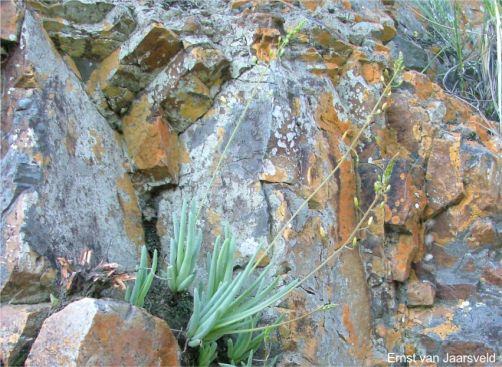
Fig. 1. Bulbine retinens in full flower in habitat on the sheer cliffs of the Kouga River, between Joubertina and Haarlem, the flowers still closed because it was taken in the morning.
Description
Description
Plants evergreen, rosulate and cluster-forming, and growing up to 90 mm high (without flowers), 90 mm in diameter, bearing 3–9 rosettes. The tubers are oval, 12–20 × 10–15 mm, covered with dry remains of amplexicaul leaf bases which weather to a fibrous network; flesh yellow. The roots are grey, fleshy, terete, stubby, 1.5 mm in diameter. Leaves 5–7, in apical rosette, forming short neck at base, and up to 7 mm long, erect, soft-textured, linear, subterete, upper surface becoming flat towards base, 50–80 × 5–7 mm; surface smooth, grey-green to bluish owing to dense powdery bloom, faintly striate, the leaf ends in a sharp point. The inflorescence more or less 350–490 mm long, ascending, 17–35-flowered in upper half. The raceme 230–310 mm long and stalk of the inflorescence 2–3 mm wide at base, terete. The bracts three-angled (deltoid) and tapering to a point, 2 × 1 mm, clasping. The flower stalks (pedicels) 14–17 mm long. The perianth is star-shaped (stellate), becoming reflexed, drooping, about 15–20 mm diameter. The tepals pale orange-yellow, outer tepals elliptic, 11 × 3 mm, inner tepals ovate to ovate-elliptic, 12 × 5 mm, obtuse. The stamens (male part) 8 mm long. Ovary (female part) rounded (globose), 1.5 mm in diameter with an erect style up to 6 mm long. The fruit is obovate, up to 6 mm long, 2 mm thick, pendulous, orange when ripe, splitting at the carpels but retaining seeds for 1–3 days. The seeds (10–30 per fruit), 2.2 × 1.2 × 0.9 mm, indistinctly angular, dull brownish black, finely pitted. Flowering time (phenology) is in spring and summer in its native habitat. However in cultivation the flowering time is somewhat extended.
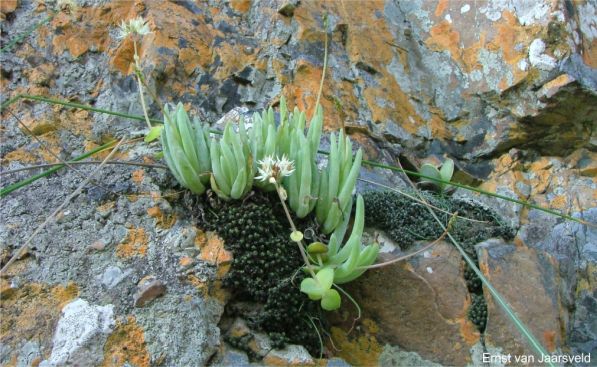
Fig. 2. The Kouga bulbine in habitat along the sheer upper cliffs of the Kouga River on the farm Hoeree, sharing its habitat with moss and Crassula pellucida subsp. marginalis in full flower.
Conservation Status
Status
Although a rare endemic as yet only known from a single river system, the Kouga River in the Eastern Cape, the plants grow on sheer south-facing cliffs and steep slopes and are thus well protected by its difficult to reach habitat, and its distribution falls within a greater conservation region. Consequently it is assessed as Least Concern (LC) by Red List of South African Plants.
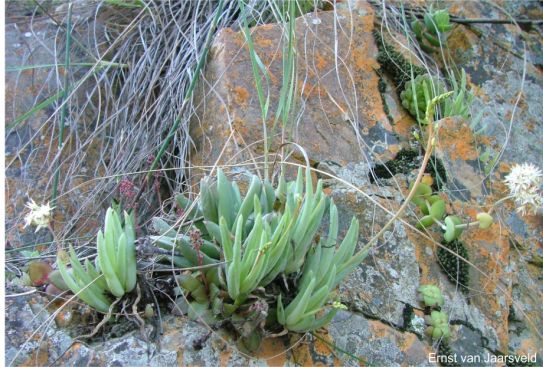
Fig. 3. Bulbine retinens, a rare endemic only known from a small region along the Kouga River, here sharing its habitat with other cliff-dwelling succulents such as Crassula orbicularis, Crassula pellucida subsp. marginalis, Haworthia herbacea and a species of Machairophyllum.
Distribution and habitat
Distribution description
Bulbine retinens is known only from the Kouga River in the southwestern portion of the Eastern Cape, in the vicinity of the Farm Hoeree and Skrikrivier tributary, between Haarlem and Joubertina. The Kouga River, which drains parts of the Kouga Mountain range, has dissected the local coastal mountains into a gorge, joining up with the Baviaanskloof River, Grootrivier and ultimitaly the Gamtoos River whichflows into the Indian Ocean at Gamtoos Mouth, close to Jeffreys Bay. It grows on quartzitic sandstone cliffs along the Kouga River, where it is locally abundant, at an altitude of 500-800 m. Plants grow in clusters, firmly rooted in crevices, and its size depends on the growing space allowed by the crevice. Temperature is high in summer, reaching 30–35°C. Winters are cooler but frost is absent. The average daily maximum temperature is about 24°C and the average daily minimum 10°C. Rainfall occurs throughout the year but more so in summer, ranging from 300–400 mm per annum.
The associated vegetation consists of Gamtoos Thicket and dry Fynbos at higher altitudes. Associated cliff-dwelling plants growing in its habitat include: Crassula orbicularis, Crassula pellucida subsp. marginalis, Crassula rupestris subsp. rupestris, Machairophyllum sp., Cyrtanthus montanus, Drimia uniflora (= Litanthus pusillus), Haemanthus albiflos, Haworthia herbacea var. herbacea (= H. translucens), Albuca bracteata (= Ornithogalum longibracteatum), Crassothonna capensis (= Othonna capensis), Caputia scaposa and Veltheimia capensis. The geology conists of light-coloured and smooth-textured quartzitic sandstone of the Peninsula Formation (Cape Supergroup). The cliffs with many ledges, crevices and fissures, and ideal for the establishment of plants.
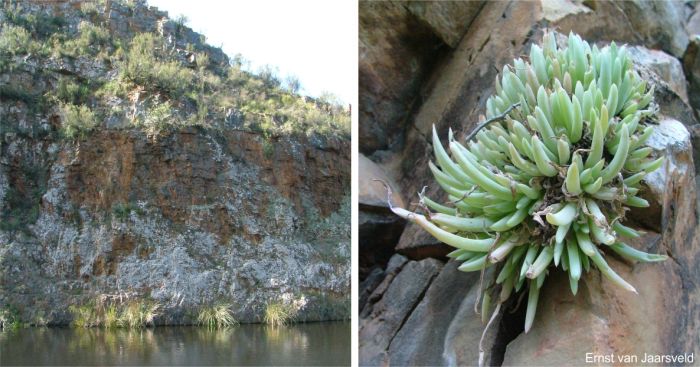
Fig. 4. (left) The Kouga River cliffs, habitat of the Kouga bulbine (Bulbine retinens) and many other cliff-dwelling succulents and numerous lichens also grow here due to the moist air. (right) A cluster of more than a dozen heads (rosettes) of the Kouga Bulbine growing in a crevice on a cliff along the southern cooler aspect.
Derivation of name and historical aspects
History
Bulbine retinens was named by Steven Hammer and the author in the Aloe Magazine in 2005 from plants collected by the author on the farm Hoeree on the cliffs along the Kouga River. The specific epithet retinens pertains to the capsules retaining and not immediately releasing the seeds.
Bulbine retinens is at once distinguished from the other dwarf-sized, cluster-forming, cliff-dwelling Bulbine species by its ascending, linear leaves arising from a short neck, its oval tubers covered with fibrous, reticulate remains of leaf bases, and its peculiar mode of seed retention. Bulbine retinens is related to both Bulbine cremnophila of the Baviaanskloof to the north of Hoeree, and the widespread Bulbine rupicola of the Kouga Mountains to the east. The leaves of Bulbine cremnophila are distinctly curved, linear-lanceolate. The growth of Bulbine retinens is larger and more rubust. Bulbine rupicola is a dwarf-sized species with short, erect, lanceolate, green leaves up to 60 mm long and with hairy (ciliate) margins.
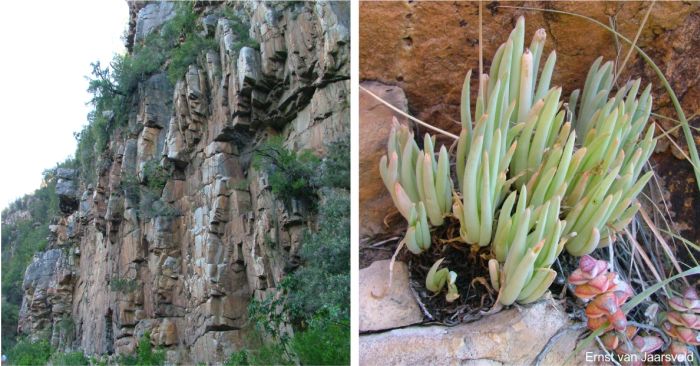
Fig. 5. (left) The Kouga River cliffs in a sunny situation away from the river and with a lesser diversity of succulents and no lichens, but also the habitat of the Kouga bulbine (Bulbine retinens) and other cliff-dwelling succulents. (right) Bulbine retinens on a sunny north facing cliff sharing its habitat with Crassula rupestris which usually grows on exposed sunny cliffs.
Ecology
Ecology
Bulbine retinens is a cluster-forming, cliff hugging succulent that grows in a relatively safe cliff-face environment, protected from fires and larger herbivores. Its succulent nature enables it to survive periods of drought. The leaves are covered in a powdery bloom resulting in the greyish green leaves, a drought adapted feature.
Growing on the south face of cliffs (southern hemisphere) has the advantage of being out of direct sun, and it retains moisture longer than the sunny aspects. Many succulents and lichens soon settle on the south face. There is thus a marked difference in succulent occurrence and density when the cooler south-facing aspect vs the sun-exposed northern cliff face is examined within the same region. The northern face also has succulents, including the Bulbine retinens, but in much smaller numbers.
The flowers are sweetly scented and usually open in midmorning and close again by dusk. There are several theories why flowers close up during the night, a behaviour known as nyctinasty. Some theories postulate it is to keep its pollen dry because dry pollen is lighter and easier to transport, or to conserve the energy to produce their scent. Charles Darwin suggested it serves to protect them from cold damage. It might very well be a combination of characteristics.
The fruits of Bulbine retinens are invariably pendulous. After pollination it starts to swell and become ripe within 2 weeks. Dispersal is unique in the sense that the dry capsule seams begin to split but retain the indistinctly angular, dull brownish black seed for one to three days, unless they are strongly shaken, for example by wind in the habitat. Other species of Bulbine shed their seed spontaneously after the carpels split. Many succulents from this region, which receives rain in winter and summer, are evergreen. This is an adaptation to the regular moisture supply throughout the year. The seeds of the Bulbine retinens ripen during summer and autumn, coinciding with the the rainy season. Germination occurs within 14–21 days.
Bulbine retinens divides, forming small clusters. The continual division and filling of crevices represents an efficient vegetative backup dispersal strategy. Individual branches of the clusters will root and continue to grow when landing on an adjacent ledge, maximising survival (vegetative backup).
Growth on shallow ledges and crevices is limited and most plants not able to survive long should their seeds germinate here. The obligatory cliff dwellers have the advantage of having little competition from non-succulent plants because if their seeds germinate here they soon succumb to the dry conditions. The survivors are succulents, bearing light seeds that are dispersed by turbulent winds and perhaps that is the explanation why this species seeds are retained for a few days awaiting strong turbulent gusts of wind to shower the cliff with its seeds.
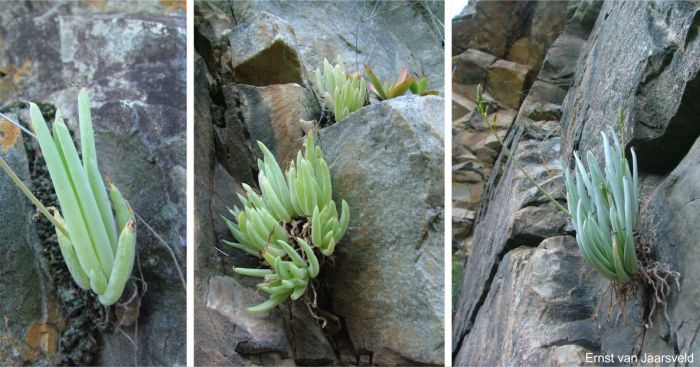
Fig. 6. (left) A young Bulbine retinens plant in a vertical sandstone crevice. (centre) Two clusters growing at Hoeree. (right) A young plant about to come into flower on a shady cliff.
Growing Bulbine retinens
Grow
Bulbine retinens is another cliff-face specialist that is easily grown in containers. In colder climates it is best kept indoors. In its natural habitat, rain can occur at any time of the year, thus water sparingly throughout the year. The young plants starts solitary, soon dividing forming small dense clusters. Plants are adapted to grow in limited crevices and are thus great for small containers.
The soil should be sandy and well-drained and preferably slightly acidic, as is found in its natural habitat. They will react to any fertiliser but organic fertilisers are best, such as well broken down compost. As a pot plant, it is best on a balcony or windowsill.
Divide plants at any time of the year, and plant in a shallow tray in a sandy mixture, such as peat, sand and polystyrene and keep moist. Rooting is within 3 weeks and once well-rooted, transfer to individual containers. Place container in a shady position but with full light. The south side of a building is ideal.
Sow seed in spring or summer in a sandy slightly acidic medium. First moisten the substrate with fine rose. Cover the seeds lightly with a thin layer of sand. Keep moist and in a shady position. Germination is usually within 3 weeks and the young seedlings relatively fast growing. Transplant seedlings to individual containers once large enough to handle.
Plants are relatively disease free but a ring fungus (Uromyces sp.) can sometimes be a problem on the related, Bulbine rupicola and B. cremnophila plants. Also in a garden environment, slugs and snails can damage plants.
References
- Mucina, L. & Rutherford, M.C. (eds) 2006. The vegetation of South Africa, Lesotho and Swaziland. Strelitzia 19. South African National Biodiversity Institute, Pretoria.
- Raimondo, D., Von Staden, L., Foden, W., Victor, J.E., Helme, N.A., Turner, R.C., Kamundi, D.A. & Manyama, P.A. (eds) 2009. Red list of South African plants. Strelitzia 25. South African National Biodiversity Institute, Pretoria.
- Van Jaarsveld, E.J., Hammer, S. & Van Wyk, A.E. 2005. Bulbine retinens, a new cliff-dweller from the Eastern Cape. Aloe 42(1 & 2): 14–15.
- Van Jaarsveld, E.J. & Van Wyk, A.E. 2003. Four new cliff-dwelling Bulbine taxa (Asphodelaceae) from the Eastern and Western Cape. Aloe 40(1): 4–7.
Credits
Ernst van Jaarsveld
Kirstenbosch National Botanical Garden (Retired)
Babylonstoren Farm (Current)
Extraordinary senior lecturer and researcher,
Department of Biodiversity and Conservation, University of the Western Cape
October 2025
Plant Attributes:
Plant Type: Succulent
SA Distribution: Eastern Cape
Soil type: Sandy
Flowering season: Spring, Early Summer
PH: Acid
Flower colour: Yellow
Aspect: Shade, Morning Sun (Semi Shade)
Gardening skill: Easy
Special Features:
Horticultural zones
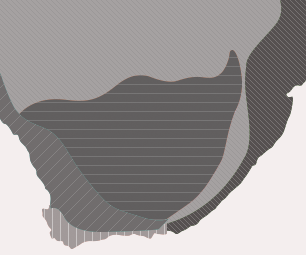






Rate this article
Article well written and informative
Rate this plant
Is this an interesting plant?
Login to add your Comment
Back to topNot registered yet? Click here to register.